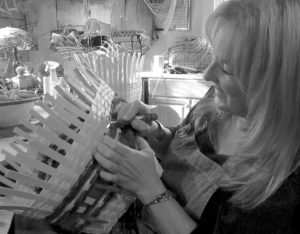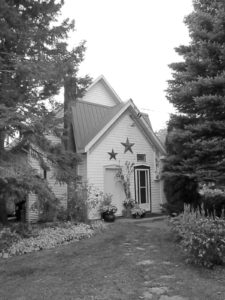Columnists
Of fedges and such

A master of the art of basketry Melissa Sherman works with varied materials in creating authentic free-form designs.
They say that rivers hold memory and, if impeded, will eventually re-trace their natural course. Humans are much like that. Inclinations inherent in our bones will, over time, subtly draw us to inner purpose…or something to that effect. Take Melissa Sherman for example: “I’m both a gypsy with my life and a gypsy with my art,” she begins. “Born in Pennsylvania, as a child I began making placemats, gathering anything I could find in the yard…I always wanted to weave things.”
I sit across a table from Melissa. The light of three o’clock fills a room of ordered chaos, where rolls of sea grass, split ash and maple sheared into strips hang on the walls; where strands of dried willow are suspended in ceiling rafters. “I’m playing today,” Melissa declares. She guides me through the anatomy of a basket. “This is reed from rattan, a thorny rattan vine…this is black walnut in strips…maple and ash are the main ones. I’m also incorporating hand-spun yarn into the weave. I work in mixed mediums, preferring free-formed shapes…doing your own thing rather than patterns,” she says. She also mentions that she has ‘pioneer hands’…a working person’s hands: hands that play banjo, bass and guitar I also discover. Melissa is a Bluegrass musician and an award winning songwriter.
Like verses in a song, Melissa is deliberate in her phrasing while mounting a conversation that runs from past lives to present and back again. Through it all, her fingers coddle lean strips of wood veneer over and under each other until they begin to take on the shape of a basket. “While living in Wisconsin I taught basket weaving and had a store that sold weaving supplies. As a single mom, weaving looked after us, helping to raise my three kids. Eventually with the pressures of business, I got away from the art and lost myself,” she muses.
Melissa interrupts to command her dog, Mijo, to settle on his blanket. Holding a smallish hook-like affair in her hand she resumes her work. “I’m packing the weave down…to tighten the whole thing,” she demonstrates, before picking up her story. “So a woman called me one day (in Wisconsin). She was researching a book on weaving patterns and had discovered that I was a descendant of the Angstadts, a family of German origin, Pennsylvania Dutch. What I didn’t know was that there were 17 master weavers in the family stream. Some had invented what are now classic weaving patterns. There are Angstadt coverlet blankets in the Smithsonian Institute. I’m the first in the family tree to weave in 100 generations. Whereas the family members were loom weavers, the art of the basket is where I am drawn.”

A former schoolhouse in Carrying Place is studio and also home for Melissa Sherman, partner Doug and dog Mijo.
Melissa and her partner Doug live in a former schoolhouse in Carrying Place. “I remember the lilacs were in full bloom when I first came to the County. I love lilacs and I fell in love with this unique space,” she recalls. We again shift to another life chapter. “I lived in Albuquerque, New Mexico and learned a lot from the Navaho people…I just finished a burden basket the other day. It’s a squarish basket that sits on four legs…there is a Navaho legend that stems from the basket.” Melissa glances to a birch bark bowl on the table: ‘First Nation baskets all had individual purpose and were highly evolved. Some groups actively began to decorate their baskets in the 1800s when trade with Europeans began, sometimes using potato stamps with marigold, beet juice or black walnuts as stain. Having had kids, I discovered that ‘Kool Aid’ is very cool for colours to dye with.”
Melissa works in silence as I move about, taking in the mix of materials and finished baskets that fill the space. “There is a certain comfort in what I do,” she shares from across the room. “A fulfilment…picking up sticks, stones, branches…I do antler work from dropped antlers, also caning with reeds, any natural material…anything with a hardy vine that is flexible you can pretty well weave with it,” Melissa continues. She nods to the yard beyond the studio window. “You can work with day lilies, irises, honeysuckle, wisteria. You can use spruce roots as a binding, make cattail mats. Working with hand-braided sea grass and birch are favourites,” she confirms. “I grow 30 varieties of willow out there to weave with and have also started a fedge.” A fedge?
“Yep! It’s a cross between a fence and a hedge. It’s a living fence of willow. Planting six-foot strands, the willow branches root right in the ground and you weave them into fedges, tunnels, garden sculptures and watch them grow in beautiful colours. Check out the garden before you go.”
I hold a basket up to the light to better appreciate the complexity of something that is functionally beautiful by the very nature of what it is. I mention a splitash basket of mine that I take to market. She smiles: “I want to pass on my experience by way of dedicated mentoring…how it was always taught and practiced,” she says. “Weaving is a connector for me, a huge extension of who I am…,” Melissa pauses. “Getting back to basketry full time is like re-opening a natural passage…like a stream,” she adds. I gather hat and coat and before I leave I watch Melissa twist and extend the near-completed basket into varying shapes. “Yep! This one wants to be square,” she laughs.
And so in the garden I encounter row upon row of willow that pry from the ground like raspberry bushes. And then I spot the fedge. A living fence but more than that it is poem-like…song-like; willow sticks cross-stitched, primal fence of the ages.

Comments (0)